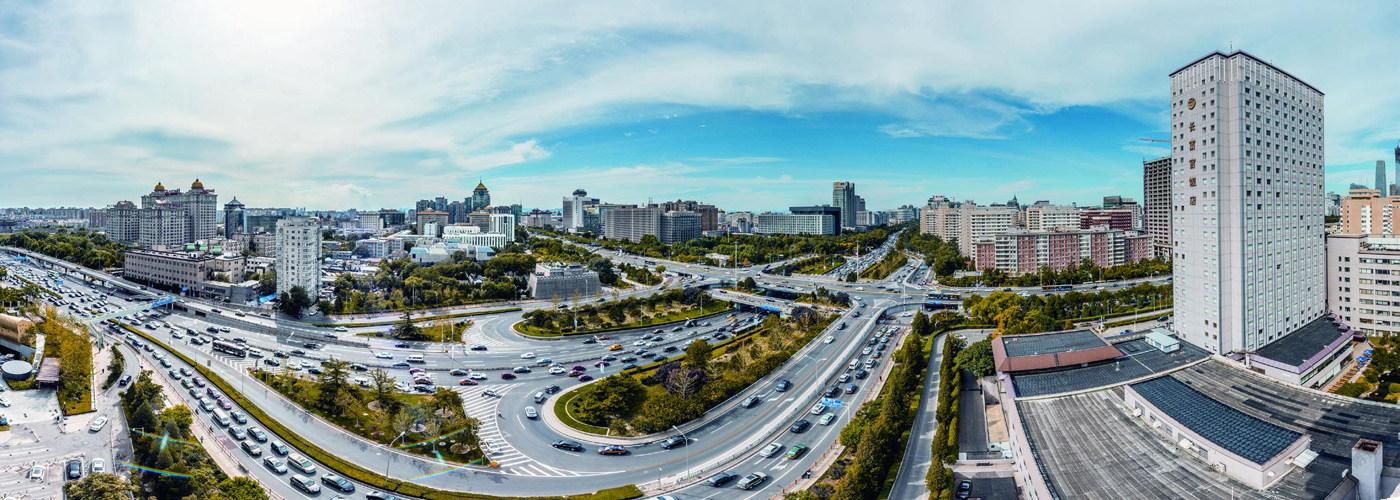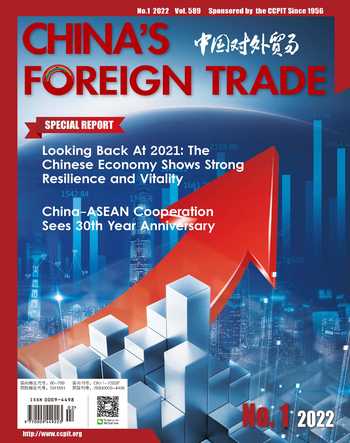The 14th Five-Year Plan Starts A New Journey to A Modernized Socialist Country
By Audrey Guo
2021 is a year of special im- portance in Chinas modernization process, since it is the first year of the 14th Five-Year Plan and the start of a new journey to build a modern socialist country.
In a period of five years, the Five-Year Plan specifies future direction for economic and social development in China, and is an important way for China to carry out development strategies and build consensus on development. In March 2021, the 14th Five-Year Plan for National Economic and Social Development and the Long-Range Objectives Through the Year 2035 (draft) was adopted on National Peoples Congress and Chinese Peoples Political Consultative Conference (NPC and CPPCC).
According to the 14th Five- Year Plan, to promote high-quality development during the 14th FiveYear Plan period, China has to carry out a new development concept for a new pattern in a new stage, insist on deepening supply-side structural reform, establish an effective system to encourage domestic demand and build a strong domestic market, unswervingly promote reform and opening-up, strengthen the leading role of domestic grand circulation and the role of international circulation in improving the efficiency and level of domestic circulation, to secure healthy and mutual stimulating domestic and international dual circulation.
The new Five-Year Plan highlights high-quality development
The 14th Five-Year Plan had 20 major indicators of five categories to assess economic and social development results, and compared with last Five-Year Plan some indicators were new, some were newly described and some were deleted.
As in previous Five-Year Plans, indicators of economic development category came first. However, the plan had no specific expected average annual GDP growth rate for next five years, but proposed to keep the economy within a reasonable range and put forward specific goals according to each years situation.
Expected indicators are anticipated goals by the central government, which will be achieved mainly through independent behavior of market players. In addition to GDP growth rate, there were two other expected indicators for “economic de-velopment”: annual labor productivity growth (higher than GDP), and the urbanization rate of permanent urban residents (as high as 65% by 2025), reflecting the potential of future development.
In terms of innovation-driven development, the indicators will be upgraded comprehensively in 2025: the value added from core industries in the digital economy will be increased to 10% of GDP, the annual average growth of total R&D spending will be more than 7%, accounting for a higher percentage of GDP than during the 13th Five-Year Plan period, and the number of high-value invention patents per 10,000 people will come to 12.
The drive of digital economy for economic and social development is becoming increasingly important, so it needs forward-looking minds to develop relevant indicators, reflecting that China is aiming at leading the industrial development, promoting high-quality economic development and building a new development pattern during the 14th Five-Year Plan period.
The indicators related to invention patents had a new modifier of“high value”, meaning more attention will be paid to the quality rather than the quantity of innovation. Compared with last Five-Year Plan, “contribution of scientific and technological advances to economic growth” and “Internet access” were no longer listed as major indicators, reflecting the indicators were kept pace with the times.
Of the 20 main indicators, 7 were directly related to the well-being of people, making the plan truly considerate to peoples livelihood, including three new, namely surveyed urban unemployment rate (lower than 5.5%), number of practicing physicians (physician assistants) per 1,000 people (3.2), and nursery capacity for children under 3 years per 1,000 people (4.5).
Compared with the 13th FiveYear Plan, two indicators of rural population lifted out of poverty and rebuilt housing in rundown urban areas were moved out, since China has won the battle against poverty.
The “resources and environment” category in the 13th FiveYear Plan was replaced by “ecological conservation”, and all such indicators are obligatory targets. Although the number was cut to 5 from 10, each of these indicators has great effects. Obligatory targets are commitments to the people, and indicators that further strengthen the governments responsibility on the basis of anticipation. 13.5% and 18% of reduction in energy consumption and carbon dioxide emissions per unit of GDP respectively, and 24.1% of forest coverage rate. These indicators will fully demonstrate the “green” economic development in China.
New stage and new goals of development require the indicator system to keep pace with the times. 20 main indicators not only carry on those of previous Five-Year Plans, but also embody the innovations required by the new era, as they are more in line with the situation of economic and social development in China at present and in next five years.
Ministries and commissions are releasing development plans one after another
State-owned Assets Supervision and Administration Commission(SASAC): The digital economy, platform economy and sharing economy will be vigorously developed during the 14th Five-Year Plan period
On April 16, 2021 at the press conference, secretary general and news spokesman of the SASAC, Peng Huagang said, during the 14th Five-Year Plan period, SASAC will guide enterprises to further grasp the opportunities in a new round of technological revolution and industrial transformation, focus on key sectors of emerging industries with good foundation, features and advantages, and actively take part in the construction of new infrastructure, newtype urbanization and key projects of transportation and water conservancy, etc., vigorously develop digital economy, platform economy and sharing economy. While accelerate the cultivation of new drives for economic development.
Ministry of Ecological Environment: China exceeded 2020 carbon emission reduction goal
On June 4, 2021, according to the Ministry of Ecological Environment, the carbon emission intensity in 2020 in China dropped by 18.8% compared to 2015, exceeding the obligatory target of the 13th Five-Year Plan, while the share of non-fossil energy in Chinas energy consumption came to 15.9%, both exceeding the goals for 2020 set by China. In September 2020, China made a solemn commitment to the world that China would strive to achieve carbon emission peaking by 2030 and carbon neutrality by 2060. Therefore, in the outline of 14th Five-Year Plan and Vision 2035, it was an important topic to develop a green mind in production and lives, and to peak carbon emissions and stabilize and then decline.
Ministry of Industry and Information Technology: Accelerate the digital transformation of the manufacturing industry
The 14th Five-Year Plan for the Development of info-communications Industry (the Plan) was officially issued in November 2021, which put forward the overall goal for the 14th Five-Year Plan period, namely, by 2025 the overall scale of information and communication industry will be further expanded, the quality of development will be significantly improved, the construction of a new digital infrastructure is basically completed which is high-speed and ubiquitous, integrated and interconnected, intelligent and green, safe and reliable, the innovation capacity will be greatly enhanced, new business models will flourish, and the ability to empower digital transformation and upgrading of the economy and society has been comprehensively strengthened. By the end of 2025, the information and communication industry will reach a new level of green development, with a 15% reduction in comprehensive energy consumption per unit of total telecom services, and the PUE value of newly-built large and super-large data centers below 1.3.
General Administration of Customs: Enhance the cooperation of the Belt and Road
On July 27, 2021, the General Administration of Customs issued the 14th Five-Year Plan for Customs, specifying the development and implementation plans for the Belt and Road cooperation, construction of free trade zones, public health at ports, intellectual property protection, bio-safety at national gateway and anti-smuggling, etc. According to the plan, in the next five years, members of international customs cooperation mechanism along the Belt and Road will increase from 53 in 2020 to more than 90 in 2025, and the number of countries (regions) interconnected with China through overseas “sole window” will increase from 1 at present to 15, the number of countries(regions) who signed AEO (Authorized Economic Operator) mutual recognition arrangements with China will top 60 from 42. In next five years, 35 international sanitary ports will be constructed in China, to enhance the ability of Chinese ports to respond quickly and effectively to public health emergencies.
Intellectual Property Office: Ensure the milestone goal of constructing a strong intellectual property rights powerhouse as scheduled
In late October 2021, the State Council issued National Plan for Protection and Application of Intellectual Property Rights During the 14th Five-Year Plan Period, specifying “four new goals” for the IP-related work, which include scaling new heights in IP protection, achieving new results in IP application, reaching a new stage in IP services, and making new breakthroughs in international IP cooperation. Meanwhile, it proposed to 8 anticipatory indicators, including in 2025 lifting the number of high-value invention patents per 10,000 people to 12, the number of overseas invention patents granted to 90,000, the registered amount of intellectual property pledge financing to RMB 320 billion, the total annual import and export value of intellectual property royalties to RMB 350 billion, the value added from patent-intensive industries to 13% of GDP, the value added from copyright industries to 7.5% of GDP, the social satisfaction rate of intellectual property protection to 82, and the conviction rate of first instance civil intellectual property cases to 85%, in order to ensure the milestone goal of constructing a strong IPR powerhouse will be completed as scheduled.
Ministry of Commerce: Boost and deepen innovations in science and technology, institution, industry and business models
Recently, the Ministry of Commerce issued the Plan for High-quality Development of Foreign Trade during the 14th Five-year Plan Period, which highlighted the deepening innovations in science and technology, institution, industry and business models, outlined 10 major tasks including green trade, trade digitalization, integration of domestic and foreign trade and other new trends in international trade, to provide guidance for the innovative development of foreign trade. In 2021, new industrial forms brought new growth: more than 2,000 overseas warehouses were built, and in the first ten months from January to October of 2021, cross-border e-commerce import and export grew by 19.5%. According to the plan, during the 14th Five-Year Plan period, China will further expand the opening-up of domestic market, encourage the import of high-quality consumer goods, increase the import of advanced technology, important equipment, key components, energy resources products and agricultural products in short in domestic market, optimize the list of cross-border e-commerce retail imports, further promote local processing of imports in border trade, and stimulate imports from neighboring countries, in order to vigorously develop trade of high-quality, high-tech, high value-added green and low-carbon products.
- China’s foreign Trade的其它文章
- Looking Back At 2021:The Chinese Economy Shows Strong Resilience and Vitality
- CCPIT Work Meeting 2021 Is Held Virtually in Beijing
- Joint Effort to Resolve Disputes in Intellectual Property Rights
- Six Industry Opportunities As A Result of Population Change
- Demands for Coal-fired Power Will Reach New High
- IDC’s Top 10 Predictions on China’s ICT Market In 2022

